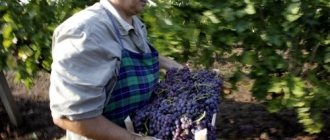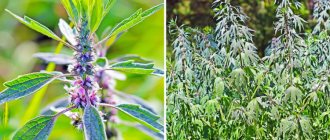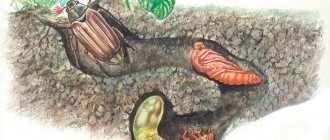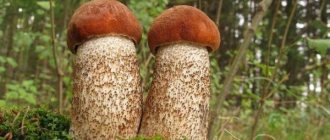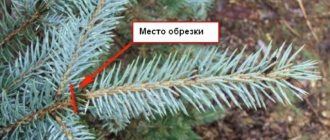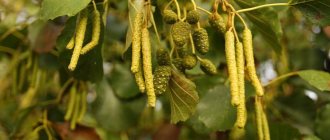Queen bee: description of the queen of the hive with photos and videos
We are talking about a female bee. She is the only one in the entire colony that has sufficiently developed genitals (worker bees lag behind in this regard).
The design of its body is similar to that of a worker bee, but it is 2.5 times its size (in this regard, it is more similar to a drone). Some organs, such as the wax and mammary glands, are not developed. But there are highly developed ovaries that provide a stable egg.
The main female also possesses a stinger hidden in the extended rear part of the body. The lifting surface of the wings is small compared to the body, so it can only fly during nuptial flight or swarming, a period of low body weight.
The name “queen bee” describes the very essence of her existence. Another name, “queen bee,” comes from the understanding of a colony as a community of rulers and subjects. It plays a major and decisive role in the existence of the bee colony.
What a queen bee looks like can be seen in the photo (surrounded by worker bees) and in close-up:
Young queen of the Buckfast species
Types of queens
For successful reproduction, it is necessary to know the root causes of the formation of queen cells in the colony and the types of queens.
Fistula
Hatched when an old female dies. The queen cell consists of a bowl (preliminarily placed on the honeycomb for the purpose of breeding the queen bee). In an emergency, bees expand the hexagonal cells on the honeycomb. The queen cells are located on the surface of the honeycomb, from which they seem to bend vertically.
The disadvantage of "emergency" females is that they are bred from older larvae; the future “head of the family” is fed with royal jelly for a shorter time than in the case of rearing from an egg. This affects its size and weight.
Swarm
Queen cells are placed along the edges of the honeycombs. The base is a built-in bowl. In this thicket the female lays eggs. The bees subsequently take care of the laid eggs - they know the growing process. The number of swarming queen cells varies, usually about 10-20.
The disadvantage of swarming dominant individuals is the maintenance of the so-called. swarming gene. In this case, there is a risk that the colony will tend to swarm more.
Silent exchange
If the queen bee ceases to satisfy the colony (mainly due to her old age), a quiet exchange is planned, i.e. breeding a new dominant individual, but without subsequent swarming. The old head of the family lays eggs in a pre-prepared bowl and, immediately after hatching the new queen, cleans up.
There are also cases described when both females live together for some time.
The shape of queen cells for silent replacement is the same as with the swarm method, but they are created in much smaller quantities: 2-4 pieces.
Quiet replacement queen bees are usually of very good quality.
How does a queen appear in bees?
The development of the queen bee is initially similar to that of the worker bee. The difference is that its larva, from the beginning to the end of development, receives royal jelly in greater quantities than the larva of a worker bee.
She is born from a fertilized egg in a cell (queen cell), the size of which is several times larger than the cells of other bees. Essentially, it floats in the queen cell in large quantities of jelly, providing it with sufficient nutrients necessary for the full maturation of all parts of the body, especially the genital and reproductive organs.
From the laying of eggs to the end of the “transformation” of the larva into an insect, 15 days pass. Then the female leaves the queen cell and receives food until full maturity. A week later, she and the guard insects set off on a wedding flight.
Hatching of queen bees
Beekeepers use 2 methods of breeding queen bees: natural and artificial. During natural hatching, bees build a queen cell in which the egg is laid. In order for an individual with reproductive abilities to emerge from it, it is intensively fed with royal jelly containing special hormones.
For artificial inference, 2 technologies are used. The most commonly used method is:
- open brood and the queen are removed from the hive, leaving only the larvae and freshly laid eggs;
- the honeycombs are trimmed from below (only in this case individuals with reproductive abilities will hatch from the eggs);
- The queen cells are cut out and placed in the hives, and the queen is returned.
The second technology is complex and rarely used: the larvae are transferred to wax sacs and artificially fed with royal jelly. However, thanks to her it is possible to obtain very high quality and most fertile queens.
When breeding queen bees, several rules must be followed:
- use only strong bee colonies;
- maintain optimal conditions for development (temperature at 32 degrees and humidity at 75-90%);
- distribute queen cells evenly throughout the family to ensure adequate feeding;
- take into account the time frame using the queen bee hatching calendar.
Hatching calendar for queen bees.
It is also important to follow a certain algorithm:
- Select strong, high-quality maternal and paternal families. The productivity of the offspring will depend on them.
- Select teacher families and organize work with them.
- Monitor the appearance of layering, the process of fertilization of the female and evaluate the result.
Why, when and how queens are removed
Since all of the hive's labor comes from the queen, the importance of her quality is beyond doubt. This is one of the prerequisites for successful reproduction (followed by the good health of the entire colony and the impeccable work of the beekeeper). Her age affects her physical fitness, family health, and productivity (amount of honey).
The most intense stimulus for breeding a new dominant individual is the removal of an existing one. This creates an instinct in insects to create a new female; they are ready to accept the creation of a queen cell.
This can be done in 2 ways:
- Removal of the queen followed by (after 9 days) removal of all queen cells created by the bees, with larvae transferred from the working cells.
- Transferring the open fruit to the comb and then (again after 9 days) transferring the whole extension to a new hive. It now contains supplies and a sealed fruit.
It is also advisable to add a container with water and a frame filled with a honey-sugar mixture in the amount of 0.5 liters per day. It consists of honey and powdered sugar in a ratio of 1:3. The ratio may vary depending on the consistency of the honey. This mixture is not subject to theft, which is beneficial. When feeding pure sugar, there is a risk of robbing the queen cell.
The breeding frame is placed in the bee colony after 9 days, on the day the queen cells are eliminated. On the 3rd day, the number of started queen cells is checked. As usual, they will ripen on the 10th day of development.
Life cycle features
There are several stages of queen bee development:
- during the first two days the egg is in the womb of the mother, then it is placed in a special bowl;
- on the third day the larva enters an open state and begins to be actively fed with royal jelly;
- on the 8th day it returns to the bowl;
- by the 12th day it matures to the state of a pupa;
- from the 13th to the 16th days it is in a pupal state;
- The 17th is the day the barren queen bee emerges.
Timing and methods of autumn feeding of bees
The queen becomes ready for mating after 4 days, and on the 5th day she already flies around the hive and mates with the drones. 10 days after this, she is already able to make the first sowings.
Important! Do not disturb the hive under any circumstances during the period of maturation of the mother; she may get scared, fly away and not find her way back, which will lead to her death.
The average lifespan of a queen bee is 5 years. However, after 2 years of her life, her reproductive functions weaken, she lays fewer eggs and sows more drones than worker bees. With all this, the old queen bee stops laying eggs earlier than expected in the fall, and, on the contrary, later in the spring. All these factors have a strong influence on the strength of the bee offspring as a whole and on the amount of honey they produce per season.
Experienced beekeepers recommend changing queens every couple of years. The best way in this case is a quiet shift.
How does mating happen?
The queen bee mates at an altitude of about 30 meters, where thermal air currents are present. Fertilization of the uterus is the task of drones. In flight, she connects with several drones, filling her sperm containers with the males' material.
The act of mating occurs at fairly high flight speeds. The drone must accurately determine the location of the female and recognize the open vaginal opening. He then shoots his inseminating organ into her body, where it locks and remains. At this moment the drone dies.
The inseminating organ, torn from his body, remains in the female's organ. The drone's work ends with the transfer of genetic information.
The female repeats the action several times until she fills her sperm containers. The contents received should be enough for her entire life. There are no more wedding flights.
Final molt
The fairly rapid development cycle of a bee from larvae does not affect the size of the bee's coat, that is, the shell, which stretches as the individual grows. At the moment when the robe becomes too small for the bee, the larva, which many beekeepers call detva, changes it in accordance with its dimensions.
It is important to take into account the fact that during the process of growth and development, the bee larva molts 4 times, the duration is about 30 minutes:
- 12-18 hours after the larva is born.
- The next molt occurs 36 hours after the first.
- For the third change of clothes, 60 hours must pass from hatching.
- The final molt occurs after 90 hours.
When the larva reaches day 6, it occupies the entire cell. At the same time, no changes are observed with molting and the body of the future bee.
Earth bees: description, methods of control
Important! After the larva molts, the shed clothes remain in the cell.
What to do if the uterus dies
What if the queen bee in the colony needs to be replaced due to the death of the old one? In this case, there are several replacement methods.
The family will carry out the replacement themselves
After the loss of a dominant female, the colony becomes restless and within a few hours builds cells to grow a new one. But to grow it, insects require eggs laid in the hive.
Maturation occurs 16 days after egg laying.
Growing from a larva
The beekeeper places closed fruit combs with young bees in the hive, into which he places pollen and honey. Subsequently, after about 1 hour, pre-diluted larvae are placed into the honeycombs. New queens hatch after about 14 days.
Introduction of an artificially grown uterus
The beekeeper purchases a “ready” artificially grown female.
Worker bees
worker bee
In spring, summer and September you can see small white worms in the cells of honeycombs. These are worker bee larvae. They emerge from eggs laid by the queen on the third day. The number of bees in hives varies at different times of the year. After wintering, the average family contains about 20 thousand insects; by the time of the main harvest there are already up to 100 thousand of them in a strong family. Worker bees are also female, like the queen, but with underdeveloped reproductive organs. It is the worker bees who create honey, wax, perform all the work in the hive, and pollinate plants.
Flying and hive bees
All worker bees in a swarm can be divided into two groups :
- The youngest, up to 20 days old, are flightless (hive) bees , which perform all the work in the nest. To empty the intestines and familiarize themselves with the location of the hive, they fly out during the day in good weather. The responsibilities of these bees include cleaning, ventilating and guarding the nest, building honeycombs, feeding the offspring, and maintaining the required temperature and humidity in the hive. They leave the hive in order to bring water or propolis, which they use to cover the cracks. Only worker bees in the family have well-developed organs adapted to this work.
- Flying bees . Their duties include working outside the hive. They bring pollen and nectar and search for honey plants. Having found a source of nectar, the bee returns to the hive and, with the help of certain body movements, gives a sign to the flying bees where to fly and how far away the honey plant is. The distribution of work among bees is carried out according to their age indicators and the condition of the hive. During its life, each working insect manages to be a teacher in the broodstock, a cleaner in the hive, and fly for nectar. Insects begin their labor activity on the third day after leaving the cell, having gained strength and become sufficiently strong.
Sometimes in the middle of a warm sunny day you can observe a significant concentration of bees at the entrance. This worries a novice beekeeper; he thinks that this is a new swarm emerging. But that's not true. These are young bees flying out for their first introductory flights. They do not fly far and are in the air, turning their heads towards the hive.
The lifespan of a worker bee depends on when it is born. Bees that appear in spring and summer live on average for about a month and a half, while the autumn offspring remain for the winter and can live up to 10 months.
The role of worker bees in the hive
Previously, there was an opinion that in the hive the head of everything was the queen. She manages the entire process of reproduction and work of bees, leading the swarm with her during swarming. But over time it was proven that this judgment was incorrect. Everything is run by worker bees. It is they that the queen follows during swarming, and not vice versa. It is they who control the ovipositor during the main feeding, limiting the queen’s food intake. And vice versa, in the spring they indulge her in every possible way, stimulating maximum egg deposition.
Bred in different ways
Hatching can be done in 2 ways: by growing from an egg or a larva. Eggs for hatching are best used when they are three days old or just before the larvae hatch. From a theoretical point of view, eggs provide the maximum guarantee of the quality of the future head of the colony. From a practical point of view, it is important to consider that egg manipulation is more complex; insects do not accept eggs as readily as larvae.
Most experts agree that breeding top females from eggs should be done by an experienced beekeeper, while general practice should focus on breeding the youngest larvae. But high-quality heads of bee colonies can be raised both ways.
Queens of different types of bees with photos
The most economically important species are considered to be 4 geographical breeds from Europe, one breed from the Caucasus and one cultivated breed created by man as a result of selection.
Ligurian honey (Apis mellifera ligustica), Italian
This is the most popular breed in the world. Its original home is the Apennine Peninsula and the island of Sardinia. This is a honey bee adapted to the Mediterranean climate. The female often lays eggs throughout the winter. To overwinter, she needs a strong hive, which leads to increased winter costs.
Dark honey (Apis mellifera mellifera), Central European dark, northern
This is a fairly large insect, characterized by a dark, shiny color and rather sparse hair on the back of the body. The female creates medium-sized colonies.
Krainskaya (Apis mellifera carnica)
The bee is medium-sized, “slender” with a dark shade, thick hair and wide, expressive gray stripes on the back of the body. Mating occurs in early spring. Thanks to intensive selection and the assistance of artificial insemination, species have been developed that meet the requirements of modern beekeepers, especially in terms of swarming and fruiting.
Buckfast (Apis mellifera Buckfast)
A very fruitful insect, which, unlike the Krajina species, does not begin mating in early spring, but lays eggs until August-September.
The queen is the key figure in the hive. She is the only fertile female in the colony; with its death, bees lose the opportunity to reproduce. No wonder everything revolves around her. The main task of the head of a bee colony is mating (at the beginning of life) followed by laying eggs.
What breeds are there?
Beekeepers can place queen bees of a certain breed into the hive. In the post-Soviet space, Central Russian and Carpathian queen bees are especially popular. The choice of breed depends on the local climate and honey collection.
Central Russian
This breed is chosen by beekeepers more often than others. The weight of the queen bee is 210 mg. Advantages of Central Russian bees:
- unpretentious and undemanding to care;
- resistant to diseases;
- productive - queen bees are distinguished by high egg production, and worker bees are industrious;
- not prone to swarming;
- immune to low temperatures - able to stay in the winter hut for up to seven months.
The disadvantage of the breed is that the bees are charged with collecting honey only from one specific honey plant.
Read more about bees of the Central Russian breed here.
Ukrainian
They are as hardworking as Central Russian bees. The weight of the fetal uterus is 200 mg. Breed Features:
- moderately calm and non-aggressive character;
- they protect the hive well from thieving bees;
- high frost resistance;
- high fertility of the uterus;
- not prone to swarming;
- take nectar only from honey plants with a high sugar content;
- resistant to diseases.
Buckfast
Buckfast dogs are bred mainly in Belarus and Ukraine. The weight of the queen bee is 260 mg. This is a productive breed, the queen can lay a colossal number of eggs, so their families are always large and do not experience a shortage of “working hands”.
It is advantageous to breed buckfasts when honey collections are located at a significant distance from the apiary. This breed is distinguished by its ability to fly long distances. Buckfasts are ready to go “to the ends of the earth” for nectar.
The disadvantage of the breed is its sensitivity to low temperatures. It is not recommended to breed it not only in northern latitudes, but even in central Russia.
Carpathian
The Carpathian breed is bred in Ukraine. The weight of the queen bee is up to 205 g. Features of the breed:
- unpretentiousness;
- cold resistance;
- can collect honey in the rain;
- honey has low sugar content;
- egg laying lasts not only in spring and summer, but also in autumn - a large family needs food.
Gray mountain Caucasian
The gray mountain Caucasian breed of bees is widespread, as the name implies, in the Caucasus and its foothills. The weight of the uterus is up to 200 g. Advantages of the breed:
- high immunity;
- non-aggressive towards the beekeeper;
- low % swarming;
- high frost resistance;
- They collect nectar from any, even the weakest honey plants.
Disadvantages: they steal honey, do not tolerate long winters well, and do not build honeycombs well.


